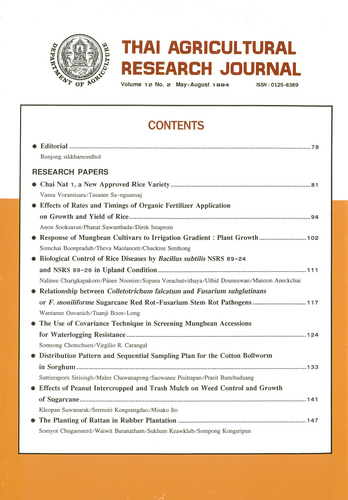The Use of covariance Technique in Screening Mungbean Accessions for Wterlogging Resistance
DOI:
https://doi.org/10.14456/thaidoa-agres.1994.14Keywords:
analysis of covariance, mungbean, waterlogging resistanceAbstract
Flooding is often a problem in rainfed lowland under pre-rice or post-rice conditions. A field study was established to identify mungbean genotypes for waterlogging resistance. The experiment involved 220 mungbean accessions obtained from Chai Nat Field Crops Research Center, Thailand and the Institute of Plant Breeding, UPLB, Philippines. The 220 accessions included the variety Pag-asa 5 and Pag-asa 1 as resistant (R) and susceptible (S) check, respectively. The S-check was also planted alternately after every five polts of the test genotypes to monitor variation in the level of flooding stress over an experimental area. The experiment was designed in randomized complete block with 2 replications. Plants were subjected to flooding twice, at 15 and 30 days after emergence. Flooding at each time lasted for six days. Data was analyzed by the analysis of covariance using an average of the 2 nearest S-checks as covariate.rnSubstantial variability among the 220 mungbean accessions was observed in most plant characteristics. Results of the analysis showed that covariance technique can be used as an efficient method to adjust for variability between the test plots. Based on yielding ability after flooded conditions, six out of the 220 accessions were classified as resistant varieties, i.e., IPB M 82 22-2, IPB M 85 22-8, IPB M 79 22-108, IPB M 82-22-2, IPB M 85 18-13 and IPB M 85 22-2, IPB M 85 these varieties ranged from 354.3 to 466.0 kg/ha while the yield of resistant check (Pag-asa 5) and susceptible check (Pag-asa 1) were 158.8 kg/ha, respectively.
Downloads
Published
How to Cite
Issue
Section
License

This work is licensed under a Creative Commons Attribution-NonCommercial-NoDerivatives 4.0 International License.
Thai Agricultural Research Journal



